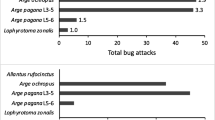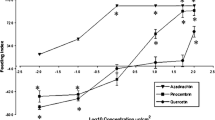Abstract
The machanisms by which the larvae of the larch sawfly,Pristiphora erichsonii (Hartig), are prevented from feeding on the single needles of the new shoot of tamarack,Larix laricina (DuRoi) K. Koch, were studied. As a result of extensive purification attempts, five deterrent chemicals were isolated and identified. They are: abietic, dehydroabietic, 12-methoxyabietic, sandaracopimaric, and isopimaric acid. These chemicals, particularly the first two, are abundant in mid-July to August in the single needles and, apparently, provide the basis for the deterrency against the larval feeding.
Similar content being viewed by others
References
Chien, J.C.W. 1960. Nuclear magnetic resonance spectra of resin acids.J. Am. Chem. Soc. 82:4762–4765.
Feeny, P. 1976. Plant apparency and chemical defense.Rec. Adv. Phytochem. 10:1–40.
Fieser, L., andFieser, M. (eds.). 1967.Reagents for Organic Synthesis. John Wiley & Sons, New York, pp. 191–192.
Heron, R.J., andDrouin, J.A. 1969. Methods of collecting, rearing, and handling the larch sawfly for experimental studies.Can. For. Res. Lab. Inf. Rept. MS-X-15.
Ikeda, T., Matsumura, F., andBenjamin, D.M. 1977. Mechanism of feeding discrimination between matured and juvenile foliage by two species of pine sawflies.J. Chem. Ecol. 3:677–694.
McNair, H.M., andBonelli, E.J. (eds.) 1969. Basic Gas Chromatography. Varian Co., Palo Alto, California, 306 pp.
Narayanan, C.R., andVenkatasubramanian, N.K. 1965. Stereochemical studies by PMR spectroscopy.Tetrahedron Lett. 41:3639–3646.
Rhoades, D.F., andGates, R.G. 1976. Toward a general theory of plant antiherbivore chemistry.Rec. Adv. Phytochem. 10:168–213.
Suzuki, A., Asano, M., Ohkubo, C., andTamura, S. 1972. Isolation ofd-pimaric and dehydroabietic acids from pine oleoresin as antinicotinic substances.Agr. Biol. Chem. 36:2051–2053.
Wagner, M. R. 1977. Host produced compounds: The basis for preferential feeding behavior of the larch sawfly,Pristiphora erichsonii (Hartig), on Tamarack,Larix laricina (DuRoi) K. Koch. MSc thesis, University of Wisconsin, 32 pp.
Wagner, M.R., Ikeda, T., Benjamin, D.M. andMatsumura, F. 1979. Host derived chemicals: The basis of preferential feeding behavior of the larch sawfly,Pristiphora erichsonii (Hymenoptera: Tenthredinidae) on tamarack,Larix laricina. Can. Entomol. 111:165–169.
Wenkert, E., Afonso, A., Beak, P., Carney, R.W.J., Jeffs, P.W., andMcChesney, J.D. 1965. The proton magnetic resonance spectral characteristics of tricyclic diterpenic substances.J. Org. Chem. 30:713–722.
Yamaguchi, K. (ed.). 1972.Spectral Data of Natural Products, Vol. 1. Torii and Co. Ltd., Tokyo, Japan, 765 pp.
Author information
Authors and Affiliations
Additional information
Research supported in part by the School of Natural Resources, College of Agricultural and Life Sciences, University of Wisconsin-Madison, under a grant from the McIntire Stennis Program. Project No. 2243.
Rights and permissions
About this article
Cite this article
Ohigashi, H., Wagner, M.R., Mastumura, F. et al. Chemical basis of differential feeding behavior of the larch sawfly,Pristiphora erichsonii (Hartig). J Chem Ecol 7, 599–614 (1981). https://doi.org/10.1007/BF00987708
Received:
Revised:
Issue Date:
DOI: https://doi.org/10.1007/BF00987708




